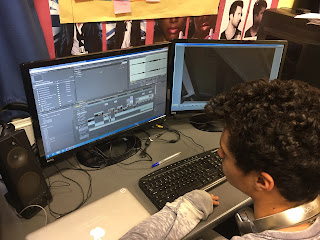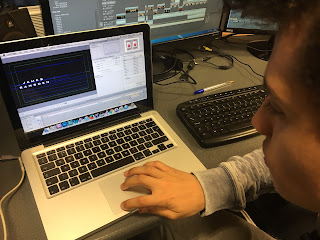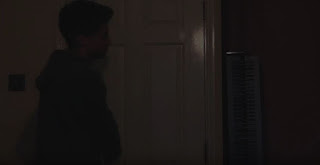Our Film Plot:
My film opening uses, develops and challenges the forms and conventions of real media products though its form, genre, narrative structure and style. Some of the real film opening that we used to influence our ideas included, 'The Blair Witch Project' and 'Contagion'.
Our film is an horror-thriller film revolving around the multiple disappearances of locals within a north London suburb in a menacing forest and then how a group of teenagers from the area enter onto the scene in an attempt to uncover the 'being'/reason behind the suggested attacks. As the film progresses the group is slowly cut down to a single girl who survives the ordeal in order to tell her story and reveal what she went through.
Form:
I think that our film opening is typical of the horror/thriller genre as it's features all contribute to its purpose of 'hooking' the audience and make them want to keep watching.
In terms of title placements our opening sequence is quite similar to that of 'The Shining' as all the credits are super-imposed onto the screen in order for the tension to continually build up without any lapses- which could be caused by cutaway titles.
 Our setting was inspired by the 'Blair Witch Project' as we thought that the use of a desolate forest to create suspense was ingenious and would therefore work perfectly in our sequence. Furthermore, the 'Blair Witch Project' is one of the most well known horror/thriller films due to the use of footage being captured on a characters camera which is then seen though the eyes of the audience. We took inspiration from this in our hand held falling scene in our sequence (as seen in the table above) as we thought this would immerse the audience even further into the film.
Our setting was inspired by the 'Blair Witch Project' as we thought that the use of a desolate forest to create suspense was ingenious and would therefore work perfectly in our sequence. Furthermore, the 'Blair Witch Project' is one of the most well known horror/thriller films due to the use of footage being captured on a characters camera which is then seen though the eyes of the audience. We took inspiration from this in our hand held falling scene in our sequence (as seen in the table above) as we thought this would immerse the audience even further into the film.
The base/majority of our opening sequence is based upon dialogue within a news broadcast. We were inspired to take on this idea by the film 'Quarantine' which, in it's opening sequence, had the a news reporter talk into a camera whilst introducing her surroundings. Similarly, our film opening has a news reporter introduce a crime.
 |
| The setting of the 'Blair Witch Project' |
 |
| A screenshot of the film opening of 'Quarantine' |
Genre conventions for horror/thriller films:
 Our setting was inspired by the 'Blair Witch Project' as we thought that the use of a desolate forest to create suspense was ingenious and would therefore work perfectly in our sequence. Furthermore, the 'Blair Witch Project' is one of the most well known horror/thriller films due to the use of footage being captured on a characters camera which is then seen though the eyes of the audience. We took inspiration from this in our hand held falling scene in our sequence (as seen in the table above) as we thought this would immerse the audience even further into the film.
Our setting was inspired by the 'Blair Witch Project' as we thought that the use of a desolate forest to create suspense was ingenious and would therefore work perfectly in our sequence. Furthermore, the 'Blair Witch Project' is one of the most well known horror/thriller films due to the use of footage being captured on a characters camera which is then seen though the eyes of the audience. We took inspiration from this in our hand held falling scene in our sequence (as seen in the table above) as we thought this would immerse the audience even further into the film.Narrative Structure:
Style:
The style of the film helps to connote its genre and support how we want it to look and feel.
1) Grading
1) Grading
Our grading was very similar to that of 'Quarantine' as the saturation and contrast is low, thus reflecting the lack of hope in the scene. Moreover, the low brightness also helps in symbolizing the dark nature of the film and its antagonist.
2) Titles
For titles we took inspiration from a very successful independent horror/thriller film, 'Sinister'. This film's opening credits not only influenced our title styling, but also how the titles appeared onto the screen and the order at which they do.
In 'Sinister' the titles are as sharp white in order to contrast the dark surroundings, we thought this was a great idea to help make them stand out without having to enlarge them- which could take away from the action. Moreover, in our title sequence we had titles come onto the screen letter by letter in a random order; this was also inspired by 'Sinister' as in that credit sequence the letters fade in, also in a random order.
For titles we took inspiration from a very successful independent horror/thriller film, 'Sinister'. This film's opening credits not only influenced our title styling, but also how the titles appeared onto the screen and the order at which they do.
In 'Sinister' the titles are as sharp white in order to contrast the dark surroundings, we thought this was a great idea to help make them stand out without having to enlarge them- which could take away from the action. Moreover, in our title sequence we had titles come onto the screen letter by letter in a random order; this was also inspired by 'Sinister' as in that credit sequence the letters fade in, also in a random order.







































